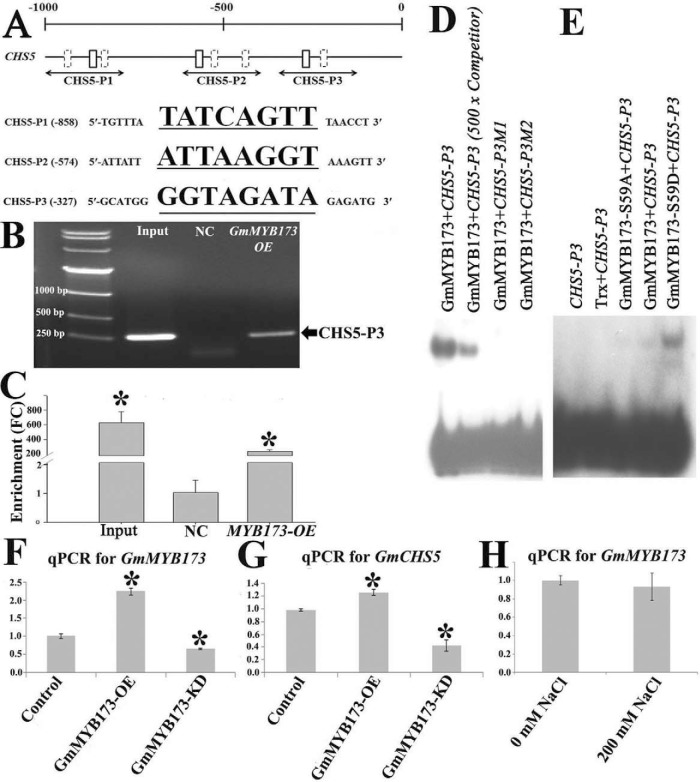Fig. 3.
GmMYB173 binds to the promoter of GmCHS5 via an MYB-binding element and regulates its expression. A, Position of MYB TF binding motifs, (G/A/T)(G/A/T)T(C/A)(A/G)(A/G)(G/T)(T/A), boxes in the promoter of GmCHS5. Fragments selected for amplification in ChIP-qPCR assay are presented proportionally underneath the promoter; sequences for probes in EMSA (solid boxes) are listed. B, C, Chromatin immuno-precipitation assay verified the GmMYB173 binding to promoter of GmCHS5 in vivo. ChIP assay reveals that GmMYB173 binds the GmCHS5 promoter (B); ChIP-qPCR-based in vivo binding assay with promoter fragments spanning the GmCHS5-P3 fragment (C, NC: Negative control, root sample transformed with the empty vector, FC: fold change). EMSA assay showed that GmMYB173 specially binds to the GmCHS5-P3 fragment from the GmCHS5 promoter (D), and Phosphorylation at S59 of GmMYB173 enhances this interaction (E). (GmCHS5-P3, ttttGTTGATGCATGGGGTAGATAGAGATGCATA) or two mutated version with its GGTAGATA core sequence changed to GCCAGATA (M1) or GGCCGATA (M2) was labeled as probe. EMSAs were carried as described in the section of Experimental Procedures. pET32a-Trx tag: the 184 aa Trx protein with two his-tags at its C terminus expressed from the empty pET32b vector. Recombinant proteins of the N-terminal 167 aa of GmMYB173, GmMYB173-S59A, and GmMYB173-S59D are fused to a Trx- and a 6 × His-tags at its N-terminal end, and a 6 × His-tag at its C-terminal end. Competitor is 5-hundred folds of unlabeled double strand GmCHS5-P3 fragment. F, G, Transcription of GmMYB173 (F) and GmCHS5 (G) in untransformed control, GmMYB173-OE (overexpression) and GmMYB173-KD (knock-down) roots; expression of GmCHS5 was found to be correlated with expression of GmMYB173. H, Transcription of GmMYB173 in soybean roots treated with 200 mm NaCl. Data represent mean values ± S.E., each sample was analyzed with three biological replicates. An asterisk indicates a significant difference based on P (≤ 0.05) of the Student's t test.

